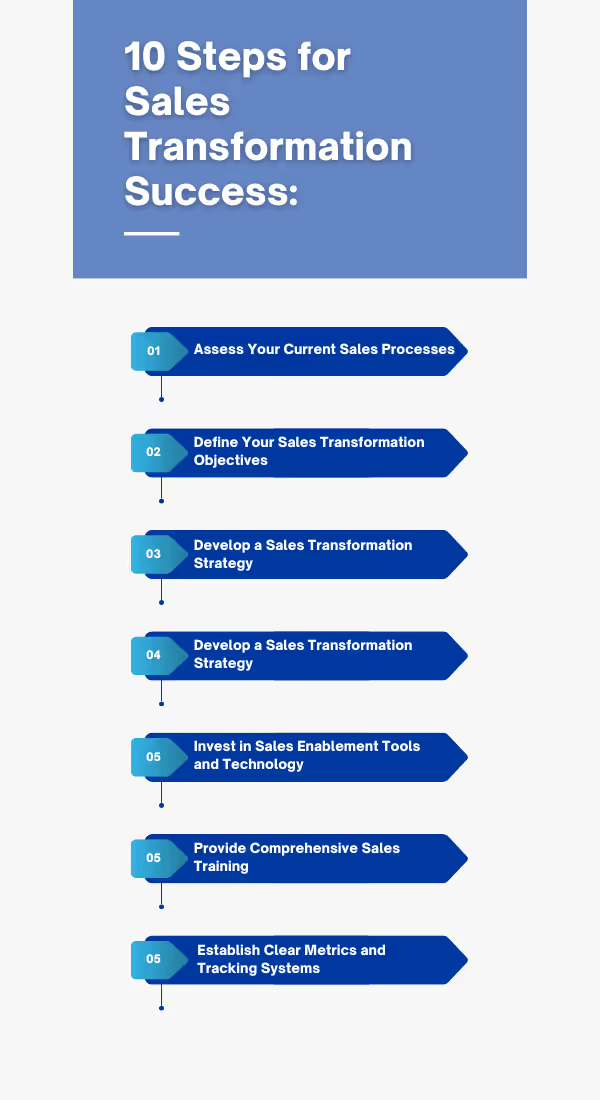
Blog
10 Steps for Successful Sales Transformation
May 28, 2023


Key Insights
In today's rapidly changing business landscape, organizations must adapt to stay competitive. One area that requires constant evolution is the sales function.
Sales transformation is the process of reimagining and optimizing sales strategies, processes, and technologies to drive growth and improve performance.
However, achieving sales transformation success is no small feat. It requires careful planning, effective execution, and a commitment to continuous improvement.
In this blog, we will guide you through a step-by-step approach to help you navigate the journey of sales transformation.
What is Sales Transformation?
Sales transformation refers to the process of fundamentally changing and improving the way a company conducts its sales activities in order to achieve better results and adapt to evolving market conditions. A compelling sales concept example of transformation could involve leveraging innovative technologies like customer relationship management (CRM) systems and sales automation tools to streamline the entire sales cycle.
It involves a strategic and holistic approach to redefining sales processes, structures, technologies, and skills to drive growth, increase revenue, enhance customer satisfaction, and optimize customer retention metrics.
Sales transformation typically involves a combination of organizational changes, process improvements, and technology implementations aimed at optimizing the entire sales cycle.
Benefits of Sales Transformation:

Implementing a sales transformation can offer several benefits to businesses. Here are some of the key advantages:
- Improved sales performance:
Sales transformation initiatives target the improvement of sales team roles by enhancing their effectiveness, efficiency, and overall performance. Through the optimization of sales processes, utilization of data-driven insights, and adoption of best practices, organizations can successfully attain higher sales volumes, increased revenue, and improved sales productivity within the sales team.
- Enhanced customer experience:
With customer-centric approaches, organizations can provide personalized experiences, tailored solutions, and seamless interactions throughout the sales cycle. This leads to higher customer satisfaction, loyalty, and increased customer lifetime value.
- Better sales team effectiveness:
By implementing effective sales coaching tips, organizations can empower their sales representatives with the essential skills, knowledge, and tools to excel in their roles. This comprehensive training, coaching, and support contribute to increased employee engagement, motivation, and retention, resulting in a highly productive and successful sales force.
- Adoption of innovative technologies:
Sales transformations often involve the integration of advanced technologies, such as customer relationship management (CRM) systems, sales automation tools, analytics platforms, and artificial intelligence (AI) solutions. These technologies enable organizations to streamline sales processes, automate repetitive tasks, gain actionable insights, and improve decision-making, ultimately driving sales growth and efficiency.
- Agility and adaptability:
The aim of a sales transformation strategy is to promote organizational agility and the ability to adapt to changing market dynamics. By continuously evaluating and optimizing sales strategies, processes, and resources, businesses can respond quickly to market shifts, competitive challenges, and emerging trends. This flexibility, supported by a robust sales accelerator system allows organizations to stay ahead of the competition and seize new opportunities in a rapidly evolving business landscape. - Data-driven decision-making:
Sales transformations emphasize the use of data analytics and metrics to inform sales strategies, identify trends, measure performance, and drive decision-making. By leveraging data, organizations can gain deeper insights into customer behavior, sales
patterns, and market dynamics, enabling them to make informed and data-driven decisions to optimize sales outcomes.
- Alignment between sales and other departments:
The process of sales transformation frequently entails dismantling silos and cultivating cross-functional collaboration within the sales funnel and pipeline. By aligning sales with other departments such as marketing, product development, and customer service, organizations can create a unified approach to customer engagement and maximize the value delivered throughout the customer journey.
10 Steps for Sales Transformation Success:

Step 1: Assess Your Current Sales Processes
Begin by evaluating your existing sales processes, methodologies, and tools, incorporating concrete sales targets examples. Identify the strengths and weaknesses of your sales team and pinpoint areas that require improvement. This assessment will serve as a baseline for your sales transformation efforts.
Step 2: Define Your Sales Transformation Objectives
Clearly define your sales transformation objectives based on your organization's goals and market conditions. Set specific, measurable, achievable, relevant, and time-bound (SMART) goals. Examples could include increasing revenue, improving conversion rates, or enhancing customer satisfaction.
Step 3: Develop a Sales Transformation Strategy
Create a comprehensive sales transformation strategy that aligns with your defined objectives. This strategy should outline the changes required in your sales processes, technology, training, and organizational structure. Consider factors such as target market, competition, and evolving customer needs.
Step 4: Communicate the Vision and Gain Buy-in
Clearly communicate the sales transformation vision and strategy, incorporating innovative sales kickoff ideas, to your sales team and stakeholders. Explain the reasons behind the transformation and how it will benefit both the organization and individual sales representatives. Address concerns, answer questions, and actively seek buy-in from all involved parties in order to foster a successful implementation of the sales kickoff ideas and overall transformation.
Step 5: Invest in Sales Enablement Tools and Technology
Identify and invest in sales enablement tools and technology, including customer relationship management (CRM) software, sales analytics platforms, sales automation tools, communication and collaboration platforms, and predictive sales analytics solutions, to streamline your sales processes and improve productivity.
Step 6: Provide Comprehensive Sales Training
Ensure that your sales team receives comprehensive training to develop the skills and knowledge needed to adapt to the transformed sales processes. Offer training programs that cover sales techniques, product knowledge, customer relationship building, and effective use of sales technology tools.
Step 7: Establish Clear Metrics and Tracking Systems
Define key performance indicators (KPIs) that align with your sales transformation objectives. These KPIs could include metrics like revenue growth, conversion rates, average deal size, or customer satisfaction scores. Implement a tracking system to monitor progress and regularly analyze the data to identify areas for improvement. By focusing on these quantifiable measures and utilizing effective revenue growth strategies, businesses can drive their sales transformation efforts with data-driven insights, optimize their processes, and ultimately achieve sustainable revenue growth.
To know more about KPIs, read our article “Want to measure your sales performance? Track these KPIs”
Step 8: Foster a Culture of Continuous Improvement
Encourage a culture of continuous improvement within your sales organization. Regularly review and refine your sales processes, strategies, and training programs based on feedback and data-driven insights. Foster an environment that encourages innovation, collaboration, and the sharing of best practices among your sales team.
Step 9: Provide Ongoing Support and Coaching
Offer ongoing support and coaching to your sales team throughout the sales transformation process. Provide regular feedback, conduct performance evaluations, and offer guidance to help individuals improve their sales skills and achieve their targets. Invest in sales coaching programs or consider assigning mentors to support sales representatives.
Step 10: Evaluate and Celebrate Success
Regularly assess the achievements of your sales transformation endeavors in alignment with the defined objectives and key performance indicators (KPIs) within the sales compensation plan. Commend significant milestones and acknowledge the contributions of individuals and teams who have played a role in the success of the sales transformation. Adapt your strategy as necessary to maintain the positive changes and tackle any remaining challenges within the framework of the sales compensation plan.
A good Sales Performance Management software can be your step one towards sales transformation!
Kennect’s SPM streamlines operations, automates menial tasks and aligns processes so that your top sales people are free to do what they do best. Sell!
Book a demo today!
ReKennect : Stay ahead of the curve!
Subscribe to our bi-weekly newsletter packed with latest trends and insights on incentives.
Thank you! Your submission has been received!
Oops! Something went wrong while submitting the form.
Your data is in safe hands. Check out our Privacy policy for more info














